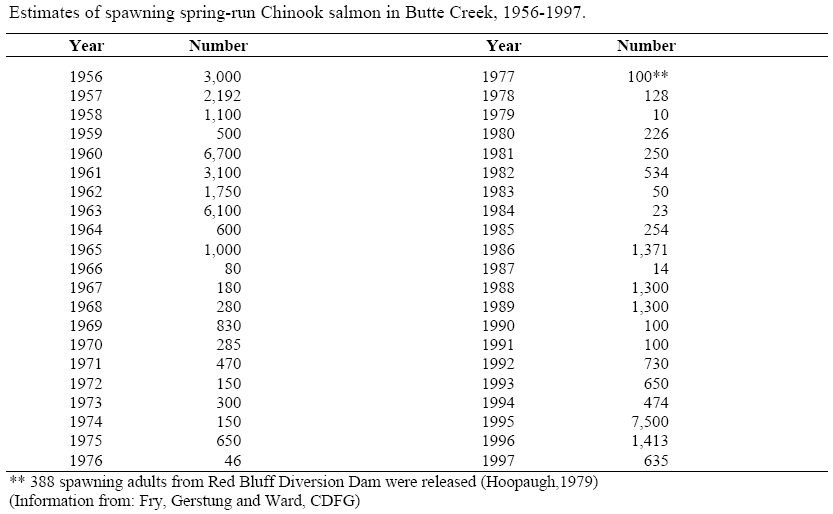|
|||||||
|
|
|||||||
| Issues : : Spring Run Chinook Salmon | |||||||
| Spring Run Chinook Salmon | Spring Run Chinook Salmon | ||||||
|
Spring-run Chinook salmon (Oncorhynchus tshawytscha) have an unusual life history pattern in that they migrate into Butte Creek during March - June (CDFG, 1993). They over-summer primarily in pools from the confluence of Little Butte Creek to the Centerville Head Dam, and begin spawning late September to early October. Unlike spring-runs in Deer and Mill Creeks, spring-run in Butte Creek presently spawn in the lower part of the creek at relatively low elevation (less than 1,130 ft) where they are hindered by the "Quartz Bowl", a natural barrier, and blocked by the Centerville Head Dam. Cramer and Demko (1997) state that "the warmer temperatures of Butte Creek during fall and winter at the elevation where spawning occurs would favor survival of a later spawning stock". It is apparent that Butte Creek's spawning and rearing waters are somewhat warmer than Deer or Mill Creek. Although the spring-run in Butte Creek migrates and spawns at similar times as spring-run in other streams, it seems to be somewhat different in that the fry emerge in December, most of these fry migrate out immediately while others migrate out in the spring (Reynolds et al., 1993). The remaining fraction remains in the stream until the following fall (1 year after they had been spawned) ( SNEP, Vol.3). This is in contrast to the pattern seen where spring-run fish spawn as well in colder, higher elevation reaches (i.e., Mill and Deer Creeks). There fry remain in the streams to migrate out starting in January, and as late as March. At higher elevations, under most conditions, fry remain to migrate out in February of the following year as juveniles. Recent evidence also shows that under some conditions Mill and Deer Creek spring-run migrate as fry (Pers. com., Ward, CDFG, 1998). Studies conducted during 1993-96 provide substantial information on timing and stage of development of salmon out migrants. Rotary screw traps were used to capture spring-run fish near Chico and in lower Butte Creek within Sutter Bypass during the September to June timeframe. Starting in 1995, juveniles have been tagged using coded wire tags to provide information on downstream migration and adult returns (Baracco, 1997). Spawning takes place during the last week in September to mid-October based on twelve years of record (Hill, 1997). The majority of fish spawn upstream from the Parrott-Phelan Diversion located a few miles west of Chico. Peak spawning density occurs from the upper limit of migration, below Centerville Head Dam and the Quartz Bowl pool (elevation 1,130 ft. at Quartz Bowl) downstream to the Covered Bridge (elevation 400 Butte Creek Draft ECR Page 86ft), a distance of about 10 miles. In Butte Creek, there is some spatial and time overlap in spawning of fall and spring-run salmon in some years (Hill, 1997; Cramer and Demko, 1997). Generally, adequate migration flow exists to the Western Canal Dam; however, during some years there are several areas above Western Canal where the majority of water is diverted, thus causing passage problems. With the new M&T Agreement an additional 40 cfs will be left in the creek so passage problems are reduced (pers.com., Ward, 1998). Based upon results of the 1993-96 studies, it appears juveniles emigrate from Upper Butte Creek predominantly as fry from mid-December through March. A lesser number of smolts emigrates March - June and yearlings emigrate the following October through January (Baracco, 1996). Substantial numbers of both Butte Creek and non-Butte Creek juveniles were found to use the Sutter Bypass for emigration. Data from juveniles tagged in Butte Creek canyon (at Parrott-Phelan Dam) shows that they can reach the Bypass in less than two weeks. Juveniles grew rapidly. In 1996, tagged fish were recaptured in the Delta as early as April 2, with one recaptured at Chipps Island as late as June 3 (Baracco, 1996). Spring-Run Chinook Salmon Population Butte Creek supported a maximum of 6,700 spring-run Chinook salmon up to 1960 (see Table 6.2). As late as the 1960ís, a run of over 4,000 adults was reported. Currently, the spring-run numbers has reported fewer than 200 adults. This represents over a 95 percent decline in the past 30 years. CDFG population estimates and PG&E fish surveys indicate that few adult spring-run salmon reach upper Butte Creek, where excellent flow, temperature, and habitat conditions are available. Between 1983 and 1985, DFG attempted to restore the spring-run by planting surplus fry from the Feather River Hatchery. In 1988, 1,300 adult spring-run salmon returned to Butte Creek to spawn, most probably a result of the hatchery release. Estimated spawning success was estimated at about 50 - 60% in Butte Creek in 1989 (Campbell and Moyle, 1992). CDFG calculated a mean run size of 500 fish (1980-1989). Butte Creek recently had the highest return of spawners ever observed at 7,500 in 1995 (Cramer and Demko, 1997). For more information see chapter 6 in the Butte Creek Existing Conditions Report.
|
|||||||
 |
Copyright © 2007 Butte Creek Watershed Conservancy. All Rights Reserved. If you have any additional questions about the Butte Creek Watershed Conservancy or have comments regarding this site please email creek@buttecreekwatershed.org | ||||||

